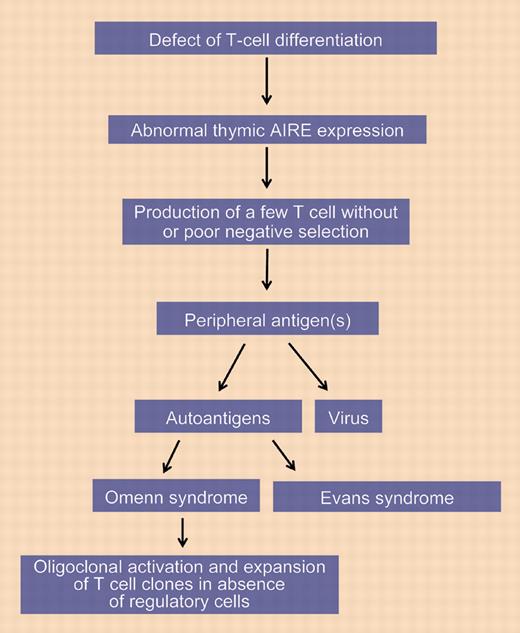Comment on Ege et al, page 4179
Omenn syndrome can be caused by ARTEMIS mutation, which strengthens the idea that potentially any conditions with deeply compromised thymopoiesis could lead to this syndrome.
Markus Ege and colleagues are reporting interesting data, that extend the spectrum of molecular defects causing Omenn syndrome (OS) to hypomorphic mutation in ARTEMIS, a key V(D)J recombination/DNA repair factor, the defect of which generally leads to T-negative and B-negative severe combined immunodeficiency (SCID) accompanied with an increased cellular radiosensitivity.1 OS is characterized by early-onset generalized erythroderma, failure to thrive, protracted diarrhea, hepatosplenomegaly and lymphadenopathies with hypereosinophilia, and elevated serum immunoglobulin E (IgE), reminiscent of graft-versus-host–like lesions or more generally of an autoimmune process. The excess production of highly restricted T lymphocytes is a major hallmark of OS, resulting from a defective V(D)J recombination process. Up to now, OS has been exclusively associated with hypomorphic mutations at RAG1 or RAG2 loci, allowing for residual V(D)J recombination activity.2,3 Hypomorphic ARTEMIS mutations have been previously reported,4 which lead to polyclonal T and B lymphocytes along with chromosomal instability and development of Epstein-Barr virus (EBV)–associated lymphoma, but no OS manifestation. The patient presented here harbors a different compound heterozygous mutation. One allele (H35D) affects a previously identified residue critical for the endonuclease catalytic activity of ARTEMIS and can be considered as a loss-of-function allele. The second allele (M1T) affects the translation initiation site, allowing for a residual activity and therefore the emergence of few T-cell clones. This report is of particular interest as it strengthens the idea that potentially any human SCID defects characterized by a profound yet incomplete block in T-cell maturation could lead to OS. These could include certain forms of IL2Ra, Jak3, IL2R, and IL7Ra deficiencies.
Although not directly connected, this paper complements a very recent report that altogether improves our understanding on this autoimmune syndrome. Cavadini et al5 demonstrated that a severe defect in the expression of the autoimmune regulator element (AIRE) characterizes the thymus of OS and SCID patients, thus providing a possible explanation for the development of autoreactive T cells that escape negative selection in OS.
While incomplete cross-talk between few developing thymocytes and stromal cells leading to impaired central tolerance can explain some of the OS's immunologic features, the in vivo process accounting for the expansion and continuous activation of these few T-cell clones in tissues such as skin and gut is still unsolved. The “Omenn” antigen hypothesis either genetically encoded (autoantigen) or provided by the environment (virus) is attractive, especially in the context of absent regulatory cells (see figure). This “antigen” could even vary within a given family. Indeed, Ege et al reported here that 2 brothers of the patient likely died from the same primary immunodeficiency before diagnosis and treatment. Each of them presented a very different clinical setting, 1 suffering for 5 years of thrombocytopenia and autoimmune hemolytic anemia reminiscent of Evan syndrome.
Altogether, these 2 reports not only greatly expand our understanding of the pathophysiology of OS on the one hand, but also clearly suggest that a diagnosis of primary immunodeficiency has to be extensively considered when facing complex autoimmune manifestations. ▪


This feature is available to Subscribers Only
Sign In or Create an Account Close Modal